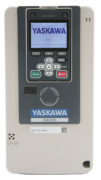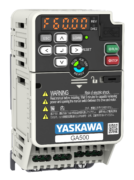Introducing the New Global Standard: 3-Level Control
Inverters that pursue high performance and ease of use in consideration of the usage environment around the world can meet high technical demands with high performance and high functionality.
In the 400 V class, the 3-level control method is adopted for the general-purpose inverter for the first time in the world, the problem of microsurge voltage is solved, and it can be used safely for existing motors.

This innovative drive utilizes 3 level control to offer the best solution for challenging installations. Yaskawa is the only manufacturer to offer a low voltage drive with this architecture. 3 level technology minimizes drive induced problems associated with long motor cables and premature motor bearing failures. In addition, overall electrical noise is greatly reduced, resulting in the most problem free installations.
An AC Drive designed for all the usage environments of the world
The Varispeed G7 has significantly reduced possible side effects on motors and power supplies. All of the complexities of switching to an AC Drive have been resolved, making it possible to quickly and easily upgrade your equipment. It’s compliant with major international standards and networks, so it can be used anywhere.
- The solution to 400V class AC Drive problems
- Global specifications
- Gentle on the environment
The Varispeed G7 offers high performance and powerful functions.
The extensive software library handles custom specifications quickly, and the entire system is designed to be user-friendly from setup through maintenance.
- High-level control performance
- User-friendly
- Easy to make exclusive AC Drive
The solution to 400V class AC Drive problems
The first 400V class general-purpose AC Drive in the world to use the 3-level control method, to approach
sine wave output voltage. It provides the solution to problems like motor insulation damage due to surge
voltage, and electrolytic corrosion of motor bearings due to shaft voltage. Existing general-purpose motors
can be used even without surge suppression filters. The noise and leakage current are greatly reduced (halvedin in-house comparison).
Features of the 3-level control method
- Low surge voltage – Suppresses surge voltage to the motor, eliminating the need for surge voltage protection for the motor.
- Low electrical noise – Significantly reduces conduction (power supply) noise and radiated noise caused by AC Drives, minimizing effects on peripheral devices.
- Low acoustic noise – Provides low acoustic noise, difficult to achieve with conventional designs.
| Range | 200 V CLASS 0.4 to 110 kW (1.2 to 160 kVA) 400 V CLASS 0.4 to 300 kW (1.4 to 460 kVA) |
| Control Method | Sine wave PWM [Vector with PG, open loop vector 1, open loop vector 2*, V/f, and V/f with PG (switched by constant setting)] |
| Frequency Control Range | 0.01 Hz to 400 Hz** |
| Braking Torque | Built-in braking transistor provided for AC Drives of 15 kW or less (200/400 V) |
| Ambient Temperature | -10˚C to 40˚C (Enclosed wall-mounted type) -10˚C to 45˚C (Open chassis type) |
| Protection Design | IP20, UL Type1 |
| Global standards | UL/cUL, CE and KC |
| Standard Communication | MEMOBUS/Modbus(RTU) (RS422/485) |
| Field buses (option card) | MECHATROLINK-II, DeviceNet, CC-Link, PROFIBUS-DP, LONWORKS, CANopen, |
**The setting range for open-loop vector control 2 is 0.01 to 132 Hz. For the 400 V class, there are limitations on the maximum output frequency depending on the setting of the carrier frequency and capacity. The maximum output frequency is 250 Hz for 90 kW to 110 kW and 166 Hz for 132 kW to 300 kW AC Drives in the 400 V class


